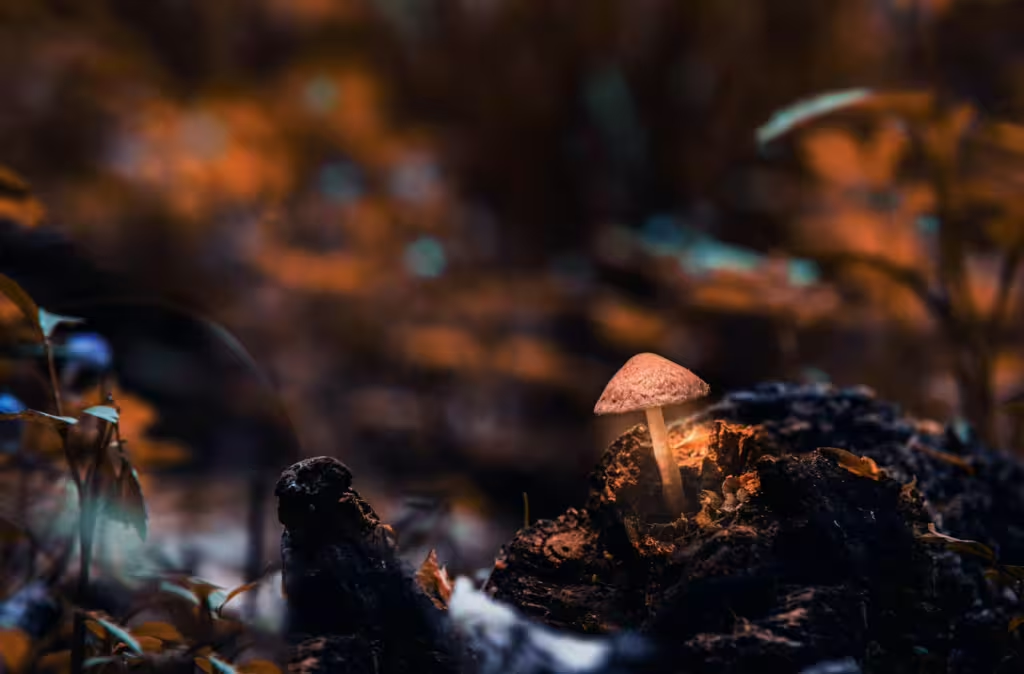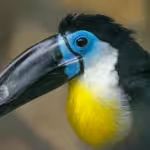The world of plants can be positively enchanting at times. They can come in vibrant, otherworldly colors, grow in strange ways and to immense size, some even have a penchant for physically devouring other living things. The more you think about it, the more you too might begin to believe that plants can be quite magical. Whether it is from intricate structures or gorgeous blooms, plants can draw our attention like few other stationary things in this world; especially those of them that glow in the dark.
Some readers might not be aware of the mesmerizing bioluminescence that exists in the plant or fungus kingdoms, but we’re here to shed light on these incredible light-creating abilities. Whether through bioluminescence or fluorescence, many plants and plant-like organisms have found fascinating ways to light up the dark with an ethereal beauty that seems almost alien at times.
In this article, we will delve into the world of glowing plants and fungi. At the same time, we will go beyond the simple visual allure of these organisms to examine the fascinating scientific theories behind the abilities themselves and the ecological function that these plants perform in the grand scheme of things.
Bioluminescence: Lighting Up from Within
When we use the term bioluminescence in this context, we are referring to the ability of living organisms to produce light within their organic forms. This is usually accomplished through chemical reactions within their cells and is most commonly associated with marine creatures like jellyfish and deep-sea fish. The ability itself is actually quite rare among terrestrial organisms and plants, in general, but has been known to occur in some fungi and within the bacteria that colonize certain plants.
The Science Behind Bioluminescence
Bioluminescence usually occurs when a light-emitting molecule (luciferin) reacts with an enzyme (luciferase). This type of reaction occurs only in the presence of oxygen and the byproduct of that reaction is, you guessed it, light. It should be noted that the reaction can become brighter based on certain co-factors like magnesium or ATP. Such elements are capable of amplifying the reaction, resulting in a brighter or longer-lasting glow.
In plants, bioluminescence usually doesn’t stem from the plants themselves but from a symbiotic relationship with luminous microorganisms, such as bacteria or fungi. An example of this brightening relationship could involve mushrooms that emit a greenish glow due to the activity of luciferin-like compounds. These types of fungi, when found in forested areas, could provide an eerie, verdant illumination within the forest, but it would be the mushrooms that are glowing, not the surrounding plants.
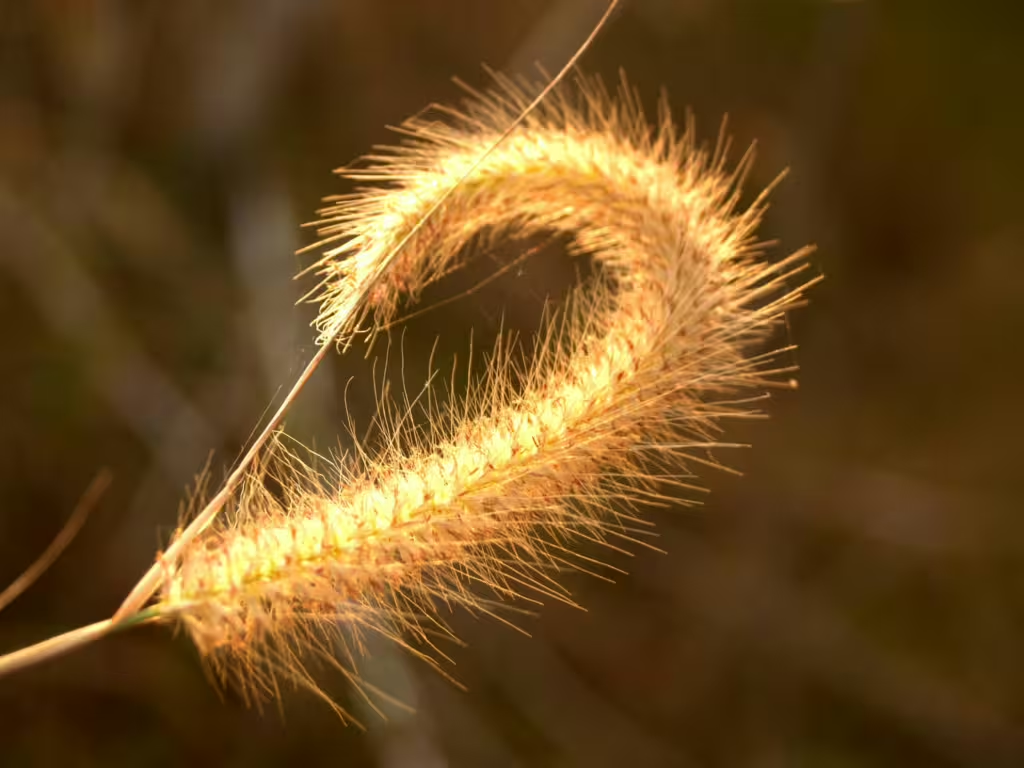
Fluorescence: Reflecting Light
Fluorescence, on the other hand, is quite different. This is a distinct phenomenon from bioluminescence and creates light by way of light absorption rather than chemical reaction. It’s actually far more simple as well. Fluorescent plants absorb ultraviolet or blue light and re-emit it as visible light. The result of this absorption is an array of bright, glowing colors when the plant is observed under UV light.
The Science Behind Fluorescence
Fluorescence occurs because certain pigments or molecules in plant tissues have the capacity to absorb high-energy light, which they then release as lower-energy light. In some flowers, flavonoids and anthocyanins (powerful antioxidant compounds often found in blueberries and other berries) contribute to this glowing effect, giving them a striking appearance under specific lighting conditions.
Examples of Bioluminescent and Fluorescent Plants
Ghost Mushrooms (Omphalotus nidiformis)
Ghost mushrooms are native to Australia, a land that is already well-known for its overabundance of unusual organisms. These mushrooms follow the Australian trend of strange and wondrous by emitting an eerie greenish glow that appears most vividly when viewed at night. Their bioluminescence is chemical-based and comes from a reaction involving the luciferin compound and the enzyme luciferase, which is powered by oxygen.
You can typically find these mushrooms growing on decaying wood, which only adds to their eerie mystique. The result of their presence is an otherworldly aura that carpets the forest floor. The spectacle created by the mushrooms has not only inspired local folklore in a number of ways, but has also drawn the continued curiosity of the scientific community.
Ghost mushrooms are most visible in complete darkness, when the moon and stars are hidden beyond the trees. Yet, as captivating as this undergrowth light show might be, its purpose is not to entertain, but the result of the actual purpose of the mushrooms themselves. Like most fungi, ghost mushrooms play a crucial role in nutrient cycling because they break down organic material, returning those spent resources back into the forest ecosystem.
Ecological Purpose:
Some readers might still be wondering, “does the glow actually do anything for the mushroom other than draw our attention to it?” The answer, as expected, is not all that simple. Scientists believe that the bioluminescence of ghost mushrooms may have evolved as a strategy for attracting nocturnal insects. These insects, drawn to the glow, land on the mushrooms. When they fly off again, they inadvertently help disperse the mushroom’s spores, facilitating reproduction and colonization in new areas of the forest.
In addition, the light could also serve as a warning signal to potential predators (humans included) from consuming these toxic fungi. As with most things that glow with what appears to be sickly, greenish radiation, it is best that you don’t try and eat these mushrooms.
Foxfire Fungi
Another bright fungi is the foxfire fungi, which can be found all over the planet. This type of mushroom emits a soft, greenish light and grows out of decaying wood that finds its way onto the forest floor. It is a subtle light, far more so than that of the ghost mushroom, but it has still mesmerized casual observers for centuries, influencing many old myths and folk tales. Many believers in such things refer to this fungi as “fairy fire,” and their existence has fueled the legends of various cultures. Magical though they might appear, their glow is derived from the same luciferin-luciferase reaction as other bioluminescent organisms. As with most mushrooms, they thrive best in damp, dank, nutrient-rich environments; further fueling their aura of mystery and magic.
Ecological Purpose:
Wherever you believe the glow comes from, it serves an important purpose for the continued survival of the foxfire fungi. This mushroom uses its hypnotic colors to attract nocturnal insects and other small organisms, which disperse its spores to new habitats in due course. Additionally, the light acts as a warning that the compounds within the fungi are either toxic or unpalatable. In either case, the mushroom thrives as a result of its coloration, further aiding in the decomposition of life on the forest floor.
Neonothopanus gardneri (Fluorescent Mushroom)
It would seem as though there are plenty of glowing mushrooms in the world, but this one is exceptionally rare. Native to Brazil’s tropical forests, the Neonothopanus gardneri is a standout in the bioluminescent world. Instead of a sickly green, it glows vibrant yellowish-green. It also happens to be one of the brightest bioluminescent glows observed in fungi. This means that it can be seen from a considerable distance and not just in the dead of night. The Neonothopanus gardneri is found primarily in humid and shaded areas, where it has adapted to draw the attention of animals, insects, and even researchers.
Ecological Purpose:
As with all these glowing mushrooms, visibility often means the difference between reproduction and stagnation. Thus, the striking luminescence of Neonothopanus gardneri is yet another means of attracting animals that can help distribute its spores out into the surrounding woods. In dark forests like this mushroom’s, striking visual cues are essential for interaction with the surrounding ecosystem. Also, this mushroom is toxic and can be rather difficult for predators to digest. The light is striking enough to attract pollinators but enough of a warning for would-be diners to keep away.
Glow-in-the-Dark Ferns
We mentioned earlier that bioluminescence was especially rare in plants, but some ferns have been known to exhibit fluorescence under ultraviolet light. These plants are basically glow-in-the-dark ferns, able to absorb high-energy UV rays and re-emit them as visible green or yellow light when the dark settles in. Such ferns can be found in shaded or low-light environments, where they serve as an understated display of natural light.
Ecological Purpose:
The fluorescence of these ferns might seem merely decorative, but it plays a functional role in managing the plant’s internal light energy. Photosynthesis is the main way that plants of every kind absorb energy and manage the bulk of their biological processes. In the dimly lit understory of forests, fluorescence helps these plants maximize their photosynthetic efficiency. How does this work? Well, by channeling any available light into wavelengths that are more easily utilized, such as low-light UV. Such an adaptation ensures that the ferns are able to thrive even in the competitive and resource-limited environment of the shady forest undergrowth.
Fluorescent Flowers (Tulips and Daisies)
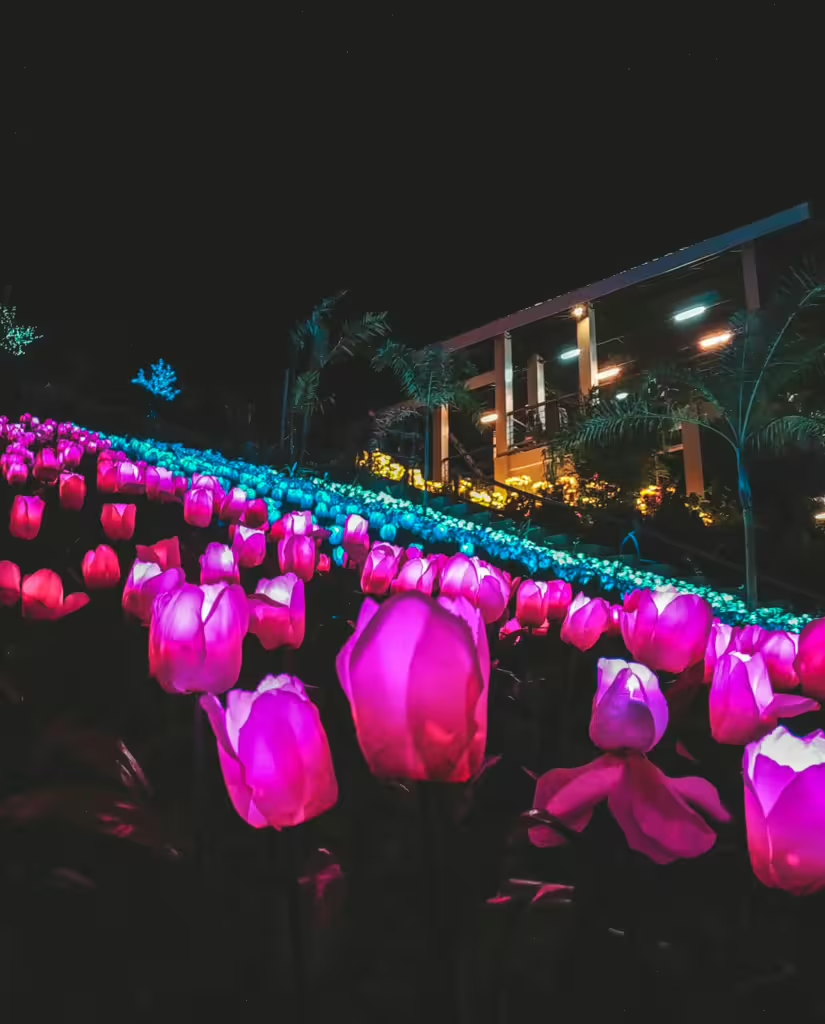
Other plants are capable of absorbing UV light as well. Certain tulips and daisies have been known to display fluorescence under ultraviolet light, though this type of display was not really observed by the naked eye until some scientist decided to throw a black light on them. This phenomenon occurs due to the presence of specific pigments, such as flavonoids like anthocynanins. These compounds absorb UV radiation and emit visible light, which can be witnessed only under sunlight or artificial UV sources. In this artificial light, tulips and daisies appear to glow with enhanced vibrancy. It is visually stunning, yes, but it also has an ecological purpose.
Ecological Purpose:
The fluorescence of tulips and daisies is important because it can actually attract pollinators, particularly insects like bees that are capable of perceiving ultraviolet light. Those colors can be detected by bees even in bright sunlight, highlighting patterns and colors that would otherwise be invisible to the human eye. By glowing this way, the flowers guide pollinators toward their nectar and pollen, ensuring annual reproductive success without much effort. We all understand how important pollinators are to the continued survival of plants all over the world, so it’s easy to see how this unique adaptation demonstrates this relationship.
Ecological Importance of Glowing Plants
So, why are glowing plants so important to the environment? They might seem like they are all surface and no substance, but bioluminescent and fluorescent plants play significant roles in their respective ecosystems. The reasons behind the inner light are often tied to continued reproduction, survival, and even communication.
Attracting Pollinators and Seed Dispersers
As we have seen in the examples above, plants and mushrooms glow as a means of attracting pollinators. Fluorescent flowers, for instance, are more visible to certain pollinators, particularly those that can detect UV light. Bees, perhaps the most famous of the world’s pollinating insects, can see the glow and are guided towards it, making a beeline to the flowers to collect their pollen and take it back to their hive. Similarly, the luminescence of fungi like ghost mushrooms can attract insects that inevitably land on them and leave to spread their spores elsewhere in the area.
Warning Signals
Most, if not all the plants and mushrooms that glow with eerie light are actually toxic when consumed. This glow might seem like a lure but it also doubles as a defense mechanism for hungry fungivores. The otherworldly light signals toxicity to potential predators, who would rather take their chances elsewhere, than become a casualty of curiosity, and the next snack the mushroom’s spores inevitably feed upon.
Enhancing Photosynthesis
In shaded environments, fluorescence enables certain plants to maximize light absorption, thereby improving their photosynthetic efficiency.
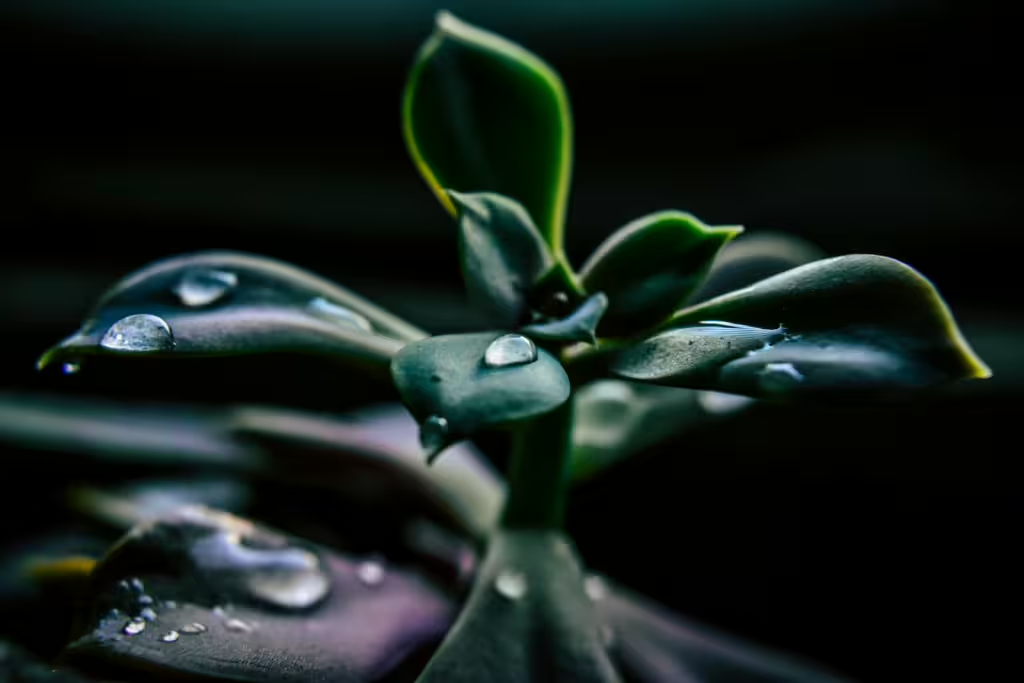
Challenges and Conservation
Sadly, the habitats of many naturally glowing fungi and plants are under threat due to human causes such as deforestation, climate change, and habitat destruction. It is more important than ever that we work to protect these unique species. Sadly, meaningful ecological protection requires concerted conservation efforts from individuals, governments, and private companies, and such coordination is difficult to achieve, even in the current age.
True Investigator Says…
As you can see, bioluminescent and fluorescent plants and mushrooms are incredible and otherworldly reminders of the incredible diversity and ingenuity of the natural world. The amazing ability these organisms possess to emit light serves essential ecological functions and captures the imagination of humanity, breeding mythology, education, and understanding. Like so many unique organisms on this planet, these plants are just a piece of the puzzle, but they too are in danger of disappearing because of human greed. To protect them, we must do all we can to shed light on their plight and the plants themselves, so that the world will see them for what they could very well be; a light in the dark.
Discover more from TrueInvestigator
Subscribe to get the latest posts sent to your email.
